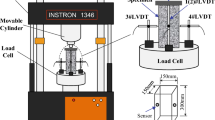To study the effect of multisize polypropylene fibers on the compression characteristics of concrete cubes, ten sets of polypropylene fiber-reinforced concrete test pieces were designed and fabricated to obtain their stress–strain curves and mechanical parameters at different ratios of coarse and fine fibers. Results for the cubes with multisize fibers were better than for those with to single-size ones. Based on test results, an improved statistical damage constitutive model for such a material is proposed.





Similar content being viewed by others
References
S. Yin, R. Tuladhar, T. Collister, M. Combe, N. Sivakugan, and Z. C. Deng, “Post-cracking performance of recycled polypropylene fibre in concrete,” Constr. Build. Mater., 101, 1069-1077 (2015). doi: https://doi.org/10.1016/j.conbuildmat.2015.10.056
P. Sukontasukkul, P. Pongsopha, P. Chindaprasirt, and S. Songpiriyakij, “Flexural performance and toughness of hybrid steel and polypropylene fibre reinforced geopolymer,” Constr. Build. Mater., 161, 37-44 (2018). doi: https://doi.org/10.1016/j. conbuildmat.2017.11.122
S. B. Daneti, T. H. Wee, and T. Thangayah, “Effect of polypropylene fibres on the shrinkage cracking behaviour of lightweight concrete,” Mag. Concrete Res., 63, No. 11, 871-881 (2011). doi: https://doi.org/10.1680/macr.2011.63.11.871
B. X. Li, M. X. Chen, F. Cheng, and L. P. Liu, “The mechanical properties of polypropylene fiber reinforced concrete,” J. Wuhan Univ. Technol., 19, No. 3, 68-71 (2004).
S. Koniki and D. R. Prasad, “A study on mechanical properties and stress–strain response of high strength reinforced with polypropylene-polyester hybrid fibres,” Cem. Wapno Beton, 23, No. 1, 67 (2018).
S. P. Zhao and B. H. Zhao, “Influences of polypropylene fibre on the mechanical performance and durability of concrete materials”, Eur. J. Environ. Civ. En., 16, No. 10, 1269-1277 (2012). doi: https://doi.org/10.1080/19648189.2012.709681
T. Aly, J. G. Sanjayan, and F. Collins, “Effect of polypropylene fibers on shrinkage and cracking of concretes,” Mater. Struct., 41, No. 10, 1741-1753 (2008). doi: https://doi.org/10.1617/s11527-008-9361-2
R. Bagherzadeh, A. H. Sadeghi, M. Latifi, “Utilization of polypropylene fibers to improve physical and mechanical properties of concrete,” Text. Res. J., 82, No. 1, 88-96 (2012). doi: https://doi.org/10.1177/0040517511420767
M. Mastali and A. Dalvand, “Fresh and hardened properties of self-compacting concrete reinforced with hybrid recycled steel-polypropylene fiber,” J. Mater. Civil Eng., 29, No. 6, 04017012 (2017). doi: 10.1061/(ASCE)MT.1943-5533.0001851
A. Caggiano, S. Gambarelli, E. Martinelli, N. Nistico, and M. Pepe, “Experimental characterization of the post-cracking response in hybrid steel /polypropylene fiber reinforced concrete,” Constr. Build. Mater., 125, 1035-1043 (2016). doi: https://doi.org/10.1016/j.conbuildmat.2016.08.068
D. Krajcinovic and M. A. G. Silva, “Statistical aspects of the continuous damage theory,” Int. J. Solids Struct., 18, No. 7, 551-562 (1982). doi: https://doi.org/10.1016/0020-7683(82)90039-7
X. R. Liu, J. B. Wang, P. Li, J. Q. Guo, and Q. Q. Zhang, “Mechanical properties and constitutive model of thenardite [in Chinese],” J. PLA Univ. Sci. Technol. , 13, No. 5, 527-532 (2012).
X. B. Li, S. M. Wang, F. Q. Gong, H. P. Ma, and F. P. Zhong, “Experimental study of damage properties of different ages concrete under multiple impact loads [in Chinese],” Chin. J. Rock Mech. Eng., 31, No. 12, 2464-2472 (2012).
CECS13: 2009. Technical Specification for Fiber Reinforced Concrete Structures. China Plan Publishing Company, Bei**g (2009).
X. R. Liu, X. Yang, and N. H. Liang, “A damage constitutive model for multi-scale polypropylene fiber concrete under compression and its numerical implementation,” J. Reinf. Plast. Comp., 34, No. 17, 1403-1412 (2015). doi: https://doi.org/10.1177/0731684415592059
Acknowledgements
This study was supported by the Research and Development Fund of Fujian University of Technology (Grant No. GY-Z17160), the Training Plan for Outstanding Young Scientific Research Talents in Colleges and Universities of Fujian Province (Grant No. GY-Z18160), the National Natural Science Foundation of China (Grant No. 41372356) and the Chongqing basic and frontier research project (Grant No. cstc2013jcyjA30005). We gratefully acknowledge these supports.
Author information
Authors and Affiliations
Corresponding author
Rights and permissions
About this article
Cite this article
Yang, X., Liang, N., Liu, X.R. et al. An Improved Constitutive Statistical Damage Model of a Multisize Polypropylene-Fiber-Reinforced Concrete Under Compression. Mech Compos Mater 55, 385–392 (2019). https://doi.org/10.1007/s11029-019-09819-8
Received:
Published:
Issue Date:
DOI: https://doi.org/10.1007/s11029-019-09819-8




